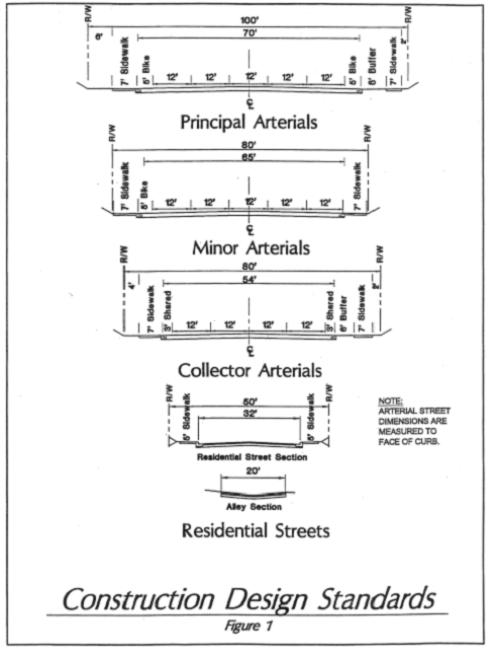Chapter 12.06
STREETS
Sections:
12.06.010 Street types, functional classification.
12.06.020 Right-of-way and pavement width standards.
12.06.030 Design standards, adjustment of standards.
12.06.040 Bicycle and pedestrian facilities.
12.06.070 Provision of street curbing.
12.06.090 Private access streets.
12.06.010 Street types, functional classification.
The Yakima urban area comprehensive plan, and/or the West Valley neighborhood plan, designates the functional classification of the principal arterial, minor arterial and collector streets and establishes their functional classification. All other streets are classified as local residential access. (Ord. 2012-30 § 1 (Exh. A) (part), 2012: Ord. 2001-13 § 27, 2001: Ord. 98-64 § 1 (part), 1998).
12.06.020 Right-of-way and pavement width standards.
Right-of-way shall be dedicated and street surfacing provided in accordance with the following:
|
|
Right-of-Way (feet) minimum** |
Pavement Width (feet) |
|---|---|---|
|
Principal arterial |
100 |
70 |
|
Minor arterial |
80 |
65 |
|
Collector arterial |
80 |
54 |
|
Neighborhood collector |
60 |
40 |
|
Residential access |
50 |
32 |
|
Alley ways |
20 |
20 |
** See Figure 1.
(Ord. 2012-30 § 1 (Exh. A) (part), 2012: Ord. 2001-13 § 28, 2001: Ord. 98-64 § 1 (part), 1998).
12.06.030 Design standards, adjustment of standards.
The preferred construction design standards for each class of street are depicted in Figure 1. Final design of street improvements is subject to approval by the city engineer. The city engineer, at his discretion, is authorized to adjust these standards as necessary to facilitate the construction of new streets and improvement of existing streets. Projects which repair small portions of or maintain existing streets shall not be considered “improvements” for the purposes of this section. (Ord. 2012-30 § 1 (Exh. A) (part), 2012: Ord. 2001-13 § 30, 2001: Ord. 98-64 § 1 (part), 1998).

12.06.040 Bicycle and pedestrian facilities.
Bicycle lanes and pedestrian sidewalks shall be provided along all new or reconstructed arterial and collector arterial streets, where feasible. (Ord. 2012-30 § 1 (Exh. A) (part), 2012: Ord. 2001-13 § 31, 2001: Ord. 98-64 § 1 (part), 1998).
12.06.050 Cul-de-sac streets.
Cul-de-sacs shall be constructed within a street right-of-way eighty feet in diameter and have an improved diameter of sixty-five feet. The maximum length of a cul-de-sac street shall be six hundred feet measured along the street centerline from the nearest through street intersection to the center of the cul-de-sac. (Ord. 2012-30 § 1 (Exh. A) (part), 2012: Ord. 98-64 § 1 (part), 1998).
12.06.060 Pattern.
A. Street pattern shall provide for the continuation or appropriate projection of existing and new streets.
B. Residential streets shall be planned to discourage their use by nonlocal traffic.
C. Right-of-way boundaries at intersections of access streets shall be rounded with a minimum radius by the city engineer to be necessary. When determined necessary by the city engineer, the boundary line intersection shall be truncated with a chord having a nominal deflecting angle of forty-five degrees.
D. Streets shall be designed to intersect as nearly as possible at right angles and in no case shall streets intersect at an angle of less than eighty degrees.
E. Local access streets with centerlines offset less than one hundred eighty feet shall not be allowed.
F. Temporary dead-end streets shall be provided with a temporary cul-de-sac at the closed end and the design shall provide for continuation of the full right-of-way width to the property boundary.
G. Alleys, if used, shall be centered on the rear lot lines and shall serve only as secondary access to lots. Dead end alleys are not permitted.
H. The hearing examiner and city council may, upon recommendation from the city engineer, require such other design standards as deemed appropriate to ensure a safe and efficient street system. (Ord. 2012-30 § 1 (Exh. A) (part), 2012: Ord. 2001-13 § 32, 2001; Ord. 98-64 § 1 (part), 1998)
12.06.070 Provision of street curbing.
Barrier curbs shall be installed along all public streets. Rolled mountable curbs may be permitted along residential access streets. Curb design shall be consistent with the standards of the city engineer. (Ord. 2012-30 § 1 (Exh. A) (part), 2012: Ord. 2001-13 § 33, 2001: Ord. 98-64 § 1 (part), 1998).
12.06.080 Street lighting.
A street light shall be installed at each street intersection and at mid block if the block exceeds five hundred feet in length. Street lights shall meet the design and placement standards of the city engineer. Lighting improvements shall become the property of the city of Yakima upon installation and will thereafter be maintained by the city. (Ord. 2012-30 § 1 (Exh. A) (part), 2012: Ord. 98-64 § 1 (part), 1998).
12.06.090 Private access streets.
Private streets may be used as sole access to new lots and development and for internal circulation within manufactured home parks and residential planned developments.
Private streets shall be constructed in conformance with following standards:
|
Potential Density |
Easement Width |
Engineered Street Plans |
Surface Width |
Surface Type |
|---|---|---|---|---|
|
3 |
30 |
No |
20 |
Paved |
|
8 |
40 |
No |
24 |
Paved |
|
16 |
50 |
Yes |
30 |
Paved |
Private streets shall be constructed with curbs, sidewalks, and street lighting and shall otherwise conform to the standards for public streets. Private streets shall provide cul-de-sac/hammer head turnaround to accommodate emergency and refuse collection vehicles. (Ord. 2012-30 § 1 (Exh. A) (part), 2012: Ord. 2001-13 § 34, 2001: Ord. 98-64 § 1 (part), 1998).


